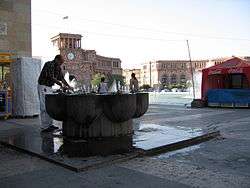Pulpulak


A pulpulak (Armenian: պուլպուլակ, Armenian pronunciation: [pulpuˈlɑk]) is a public water fountain common in Armenia and Armenian-populated Nagorno-Karabakh Republic.[1] Pulpulaks are a significant part of the Armenian culture.[2] First pulpulaks appeared in the streets of Yerevan in 1920s and over time became extremely popular. Pulpulaks were and are often used by people to appoint meetings and by couples as dating locations.[3]
Name
The word pulpulak is colloquial and derives from the sound of the murmuring of water "pul-pul", suffixed with "ak" (ակ), meaning "water source".[4][5] They are rarely referred to as tsaytaghbyur (Armenian: ցայտաղբյուր), meaning "squirt spring".
Description
Pulpulaks are small, usually one meter tall, stone memorials with running water, often fed by a mountain spring.[5] Some pulpulaks are erected in memory of dead relatives. In drinking from a memorial pulpulak, passers by give their blessing to the person in memory of whom it is constructed. Memorial pulpulaks are related to khatchkars.[6]
Yotnaghbyur
Yotnaghbyur (Յոթնաղբյուր, meaning "seven springs") is the name of the famous pupulak in Armenian capital Yerevan's Republic Square. It was erected by Spartak Gndeghtsyan in 1965. The fountain was restored in 2008 by Moscow-based Armenian designer Nur.[3]
Gallery
 Pulpulak near the Geghard monastery.
Pulpulak near the Geghard monastery.



 Pulpulak in honor of an Armenian soldier killed in Nagorno-Karabakh War
Pulpulak in honor of an Armenian soldier killed in Nagorno-Karabakh War
- in Bjni
 Pulpulak near the Gandzasar monastery in Nagorno-Karabakh.
Pulpulak near the Gandzasar monastery in Nagorno-Karabakh.
See also
| Wikimedia Commons has media related to Pulpulaks. |
References
- ↑ Hayrapetyan, Varsine (21 September 2012). "Ջուրը կյանքի աղբյուր է... [Water is the source of life]" (in Armenian). ArtsakhToday. Retrieved 24 October 2012.
- ↑ Nikita Voronov (1984). Советская монументальная скульптура, 1960-1980 (Soviet Monumental sculpture, 1960-1980) (in Russian). Iskustvo ("Искусство"). p. 221.
- 1 2 Sarukhanyan, Petros (3 May 2008). "Յոթնաղբյուրի վերածնունդը [The Revival of Yotnaghbyur]". Hayastani Hanrapetutyun (in Armenian). Retrieved 24 October 2012.
- ↑ "Пулпулак (Pulpulak)" (in Russian). Khachkar journal. Retrieved 25 October 2012.
- 1 2 "Useful information about Armenia". Armenian Travel Bureau. Retrieved 27 October 2012.
- ↑ Shahnazaryan, Gnel (5–11 July 2011). "Պատմության դասեր [Lessons of history]". Zinvor (in Armenian). Defense Ministry of Armenia. Retrieved 25 October 2012.